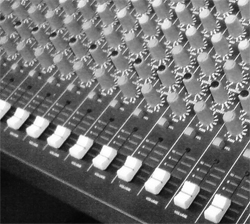
8. If you are ever prone to hitting a piece of equipment to make it work…
…once is maintenance, twice is abuse.
9. Keep your headphone volume down by using delay on your solo buses.
Slow down the solo bus with delay to sync your headphones with the PA so you don’t have to run headphones overly loud. If you’re 75 feet from a speaker cluster, try a 75 millisecond delay. Using an analog board, run the headphone out to an external delay unit and then into a headphone amp and then back to the headphones.
10. Don’t let a power outage take out your system.
Use APC units for keeping the power going to your vital audio equipment. Power can go out for a number of reasons, and using an APC unit can keep your system powered and your service going.
11. Plan on equipment failure.
Ask yourself questions like, “what could fail?” “how could we get around it?” and “what’s the least amount of equipment we need to keep the system going?” Make a plan for equipment failure so when it does happen, you’ll be prepared.
12. Use a 911-microphone.
Wireless systems go out. Wireless mic batteries die. And even DI boxes can go bad at the worst time. Set up a wired vocal microphone on a microphone stand, with a long microphone cable. Place it just off-stage. Grab an extra DI box and 1/4-inch cable and place that at the base of the microphone stand.
The next time a microphone or DI goes out during a service, you (or a musician) can pull out the 911-microphone or your emergency setup – whatever you want to call it. And in the case where it seems all the equipment comes crashing down, a church audio system only needs one channel and one microphone.
13. Don’t forget about the HPF and LPF.
The high-pass filter allows high frequencies to pass through while the low-pass filter allows low frequencies to pass through. If you don’t need low frequencies out of a channel, then engage the HPF. If you don’t need high’s from a channel, use the LPF. In the case of HPFs and LPFs that have controllable frequency points, sweep the point until it’s noticeable in the mix, then back off a little.
